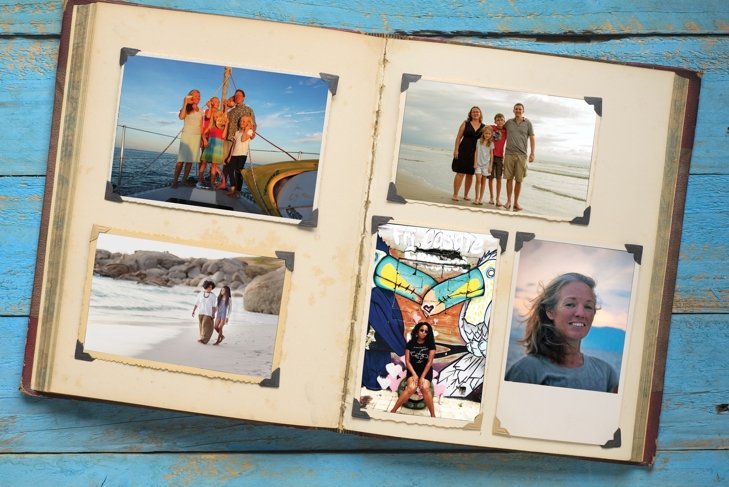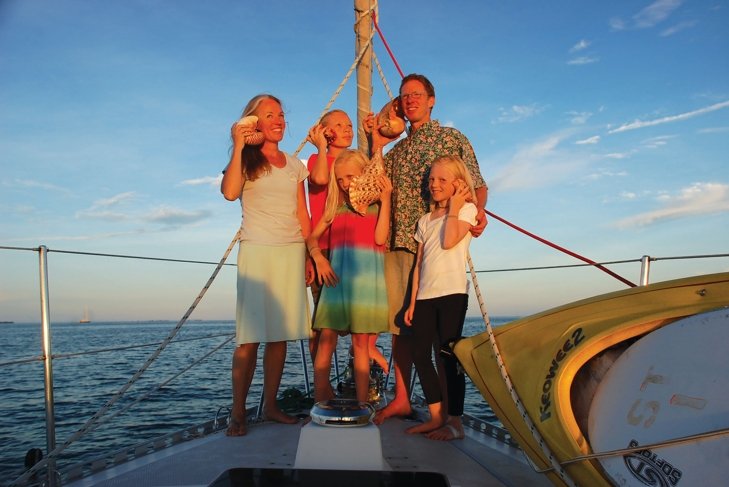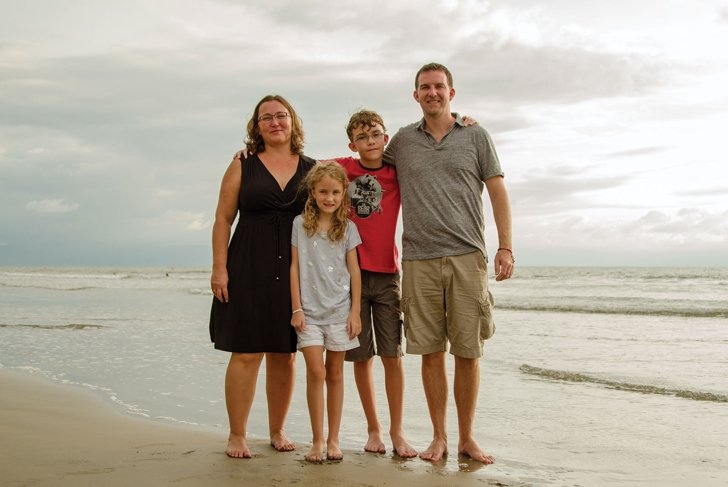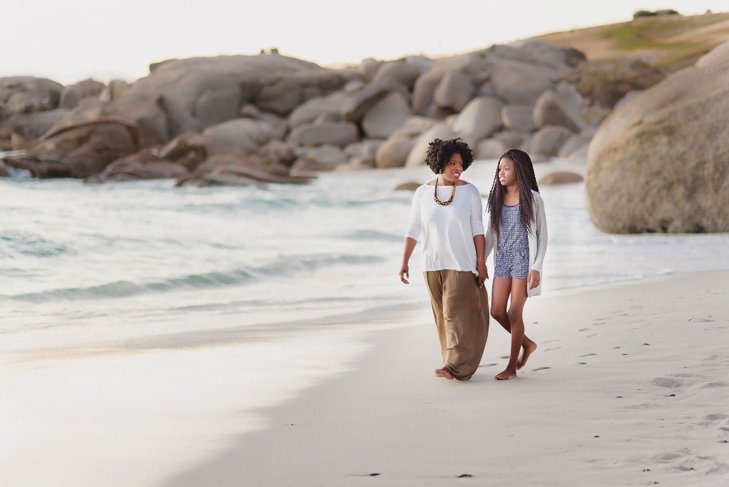
Who hasn’t fantasized about leaving it all behind and traveling abroad à la Eat Pray Love? For most of us, reality soon sets in: there are kids to care for, pets to feed, bills to pay. But for these globe-trotting families, wanderlust isn’t a distraction from daily life. It is life, with many of them spending years on the road (or water). Prepare to be inspired.
The Gifford family
Living the sweet life on deck

When I reached Behan Gifford, she was sailing through the 32 islands of St. Vincent and the Grenadines. “Can I get back to you?” she asked. “We may not have internet for a week.”
She and her husband, Jamie, along with their three children, have been floating around the world since 2008. “When we sailed from Seattle, we anticipated being away for two to five years,” recalls Gifford. At the time, their children were ages four, six and nine. “I’m stunned that we’ve entered our 10th year, with no end in sight!”
On land, Gifford and her husband were very successful by traditional standards. But as they juggled careers and parenting, they craved a different life—one that was more minimalist and where their family lived in sync with nature.
“We considered other ways to rescale and reorient our lives, but always came back to nomadic life afloat,” says Gifford. “A boat is the near-perfect magic carpet for far-flung travel.”
The Giffords literally go wherever the wind blows, sometimes switching hemispheres to avoid hurricanes. “The specifics change a lot,” she says. “You can pick the date or the place, but not both!”
This has taught them the importance of flexibility, both as travelers and as parents. Take their children’s education, for example. “Homeschooling was never something I aspired to, but it was necessary,” explains Gifford. And the family’s life on sea has become a classroom unlike any other.
“Our children have views based on first-hand experience instead of the media,” explains Gifford. “They’ve heard islanders in Papua New Guinea describe how their communities are sold out to foreign companies for timber or mining. They’ve swum on enough reefs to recognize a healthy reef ecosystem, as well as one that’s overfished or impacted by climate change. They’ve gained an appreciation for how rich their options are in life, their control over their destiny and how precious and uncommon this is in the world. It’s a priceless education.”
Learn more about the Giffords’ adventures afloat: sailingtotem.com

The Kosman family
Making memories from Hong Kong to Costa Rica
Charles and Micki Kosman live in Canada, though you’ll rarely find them there. Since 2003, they’ve traveled to more than 40 countries.
While they’ve made adjustments—for example, swapping out cheap hostels and rickety buses for more conventional accommodations and modes of transportation—the adventures didn’t stop when they had kids. “We knew children would complicate our travel, but we’d already met so many traveling families that we knew we could keep on doing it,” says Micki Kosman.
Their son was just three weeks old when they took him on an 800-mile road trip. By the time he was two years old, he’d been to much of North America, plus Cuba, Hong Kong and the Philippines. “There’s this misconception that travel with children is incredibly hard,” she says. “I honestly find that’s not the case.”
Their son is now in his early teens, and they have a daughter who is a few years younger. Kosman says that recently, “We spent 10 days in the Galapagos snorkeling with turtles, sharks and sea lions.”
The kids now have irreplaceable memories that span continents. “Our son still talks about boogie boarding in Costa Rica,” says Kosman.
Learn more about the Kosmans’ continent cruising: thebarefootnomad.com
Keeping up with the jet-setters
“Parenting can be tough,” says Micki Kosman. “We may as well be parenting somewhere beautiful when the challenges come!” Here are her tips to keep kids happy and parents sane while traveling abroad.
Go with medical travel insurance
Take other health precautions too. “I always have the addresses of the nearest hospitals in my phone,” says Kosman. Her husband packs an offline map of the area, and they carry a first aid kit wherever they go.
Look for kid-specific attractions
“We always find a nice outdoor space where the kids can run around and we can all relax,” says Kosman.
Involve kids in the planning
“Ask your kids what they want to do, and let them help you plan,” she suggests. “If the kids are as excited as you are, everyone will have a better time!”
Put a stop to travel stress
“Once a child reaches their breaking point, no one will have any fun,” warns Kosman. “Keep your days shorter, don’t pre-plan every second of your journey and spend a few more minutes playing in the park and a few less walking through museums.”
The Jones family
Creating a community of wanderers

Libryia Jones always wanted to travel, but the world kept throwing obstacles in her path. She was offered a year-long internship in China, but the school wouldn’t let her bring her daughter. Then she tried to join a group that took people abroad for a year, but they also banned children.
“I got tired of continuously getting knocked down for something I’d been dreaming of,” she says. So Jones did it herself. She started Wandering Moms with a friend. It’s a community of more than 10,000 traveling women, most of whom are single moms.
“These moms literally give their children the world!” exclaims Jones.
Jones also started a company that offers an immersive experience called “My Wander Year.” Participants live in four revolving locations for three months at a time. Recently that included the Czech Republic, Thailand, South Africa and Colombia.
She says the notion that a child’s stability requires a North American lifestyle is a misconception. “Their stability comes from their parents,” says Jones. “If they’ve got us, they’ve got stability. The routine could be the standard: school, homework, dinner, bed, repeat. Or it could be that we head to another country every three months.”
Traveling with a teen brings its own challenges, like giving them the friends and independence so many adolescents crave. “I made it a point to get her onto soccer teams in each location,” says Jones. “It was helpful to have her around girls her age.”
Jones adds, “It also helped that she had much more independence.” She notes that many countries are safer than North American cities. In Prague, her daughter would ride the tram by herself. In Thailand, she’d call an Uber to go to soccer practice.
Education can also be a challenge with an older child. Jones recommends researching the options available. “There are homeschool curriculums, unschooling and even virtual schools,” she says.
For Jones, the benefits outweigh any difficulties. “You turn things most children only learn in books into real-life experiences,” Jones says. Two of her daughter’s most memorable experiences were visiting Anne Frank’s hiding place, and standing where Nelson Mandela stood when he gave his first speech after being released from prison.
“At any time in your life, you’re able to choose the life you want,” says Jones. “Your children aren’t a hindrance to that. In fact, they should be a catalyst. Do you want to teach them that they can do anything they want with their lives? Who best to learn that from than you, and how best to teach them than by example?”
Learn more about Jones and her will to wander: wanderistlife.com





























